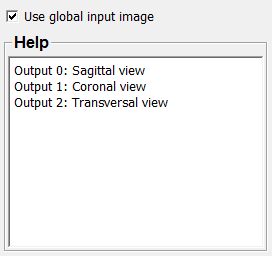OrthoReformat3¶
- MLModule¶
genre
author
package
dll
definition
see also
OrthoSwapFlip,Reformat,SwapFlipDimensions,InterleaveDimensionkeywords
Purpose¶
The module OrthoReformat3 transforms the input image (by rotating and/or flipping) into the three main views commonly used.
Windows¶
Default Panel¶

Output Fields¶
output0¶
- name: output0, type: Image¶
Sagittal view.
output1¶
- name: output1, type: Image¶
Coronal view.
output2¶
- name: output2, type: Image¶
Transversal (axial) view.
Parameter Fields¶
Visible Fields¶
Use Global Input Image¶
- name: useGlobalInputImage, type: Bool, default: TRUE¶
If checked, the module works internally on a global image (
Global Image Processing Concept). Beware of memory issues when processing huge images.Otherwise, the module works internally on a Virtual Volume (
VirtualVolume Concept).